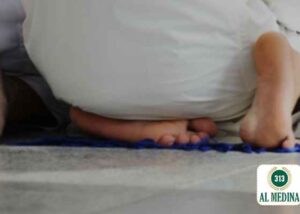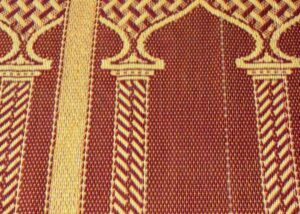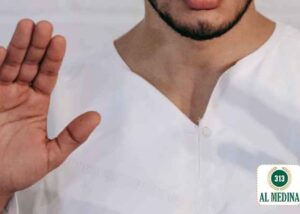Is it true that the Hadith narrations regarding placing your hands below the navel in Salah are weak?
Quran
Hadith
Islamic Text
Yes, it is true that the Hadith narrations regarding placing your hands below the navel in Salah are weak. However, so are the Hadith narrations that mention above the navel. Since there are no clear Sahih Hadith narrations on this issue, the scholars differed over it. The Hanafi position is to place them below the navel (bellybutton).
حَدَّثَنَا مُحَمَّدُ بْنُ مَحْبُوبٍ، حَدَّثَنَا حَفْصُ بْنُ غِيَاثٍ، عَنْ عَبْدِ الرَّحْمَنِ بْنِ إِسْحَاقَ، عَنْ زِيَادِ بْنِ زَيْدٍ، عَنْ أَبِي جُحَيْفَةَ، أَنَّ عَلِيًّا رَضِيَ اللَّهُ عَنْهُ، قَالَ: مِنَ السُّنَّةِ وَضْعُ الْكَفِّ عَلَى الْكَفِّ فِي الصَّلَاةِ تَحْتَ السُّرَّةِ
Muhammad bin Mahboob informed us that Hafs Ibn Ghiyath informed them, from Abd al-Rahman bin Ishaaq, from Ziyad bin Zayd, from Abi Juhayfah that Ali (May Allah Most High be pleased with him) said, ‘It is from the Sunnah to place the hand upon the hand and place them below the navel during Salah.’ (Abu Dawood, 756).
The Hadith above supports the Hanafi position of placing the hands below the navel (bellybutton) during Salah. However, it is weak due to Abd al-Rahman bin Ishaq being a weak narrator and Ziyad bin Zayd being Majhool (unknown).
عبد الرَّحْمَن بن إِسْحَاق الوَاسِطِيّ، وَنقل تَضْعِيفه عَن أَحْمد وَيحيى وَالْبُخَارِيّ وَالنَّسَائِيّ. (عمدة القاري شرح صحيح البخاري)
Abd al-Rahman bin Ishaaq al-Wasiti, his weakness has been narrated from Ahmad, Yahya, al-Bukhari and al-Nasai. (Imam al-Ayni, Umdatu al-Qari).
عَبْدُ الرَّحْمَنِ بْنُ إِسْحَاقَ الْوَاسِطِيُّ وَهُوَ ضَعِيفٌ. (فتح الباري شرح صحيح البخاري)
Abd al-Rahman bin Ishaaq al-Wasiti is weak. (Imam Ibn Hajr al-Asqalani, Fath al-Bari).
“زياد” بن زيد السوائي الأعسم الكوفي. روى عن أبي جحيفة وشريح القاضي. وعنه عبد الرحمن بن إسحاق الكوفي قال أبو حاتم مجهول روى له أبو داود حديثا واحدا عن علي. (تهذيب التهذيب)
Ziyad bin Zayd al-Sawai al-A’sam al-Kufi, he narrated from Abi Juhayfah and Shurayh al-Qadi. Abd al-Rahman bin Ishaaq al-Kufi narrated from him. Abu Hatim said he is Majhool (unknown). Abu Dawood narrated a single Hadith from him, from (Sayidina) Ali. (Imam Ibn Hajr al-Asqalani, Tadheeb al-Tadheeb).
The Hadith above is clearly weak but it is supported by the following statement of Sayidina Abu Hurairah (May Allah Most High be pleased with him). However, that narration has a weak chain too. Although it is weak, it is still helpful since weak narrations do strengthen one another.
حَدَّثَنَا مُسَدَّدٌ، حَدَّثَنَا عَبْدُ الْوَاحِدِ بْنُ زِيَادٍ، عَنْ عَبْدِ الرَّحْمَنِ بْنِ إِسْحَاقَ الْكُوفِيِّ، عَنْ سَيَّارٍ أَبِي الْحَكَمِ، عَنْ أَبِي وَائِلٍ، قَالَ: قَالَ أَبُو هُرَيْرَةَ: أَخْذُ الْأَكُفِّ عَلَى الْأَكُفِّ فِي الصَّلَاةِ تَحْتَ السُّرَّةِ، قَالَ أَبُو دَاوُدَ: سَمِعْت أَحْمَدَ بْنَ حَنْبَلٍ: يُضَعِّفُ عَبْدَ الرَّحْمَنِ بْنَ إِسْحَاقَ الْكُوفِيَّ
Musadad informed us that Abd al-Wahid bin Ziyaad informed them, from Abd al-Rahman bin Ishaaq al-Kufi, from Sayaar Abi Ishaaq, from Abi Wail who said that Abu Hurairah (May Allah Most High be pleased with him) said, ‘One hand is grasped by the other and placed under the navel during Salah.’ (Imam) Abu Dawood said, I heard (Imam) Ahmad bin Hanbal say Abd al-Rahman bin Ishaq al-Kufi is weak. (Abu Dawood, 758).
As for narrations that state the hands should be above the navel, they are weak too.
حَدَّثَنَا مُحَمَّدُ بْنُ قُدَامَةَ يَعْنِي ابْنَ أَعْيَنَ، عَنْ أَبِي بَدْرٍ، عَنْ أَبِي طَالُوتَ عَبْدِ السَّلَامِ، عَنِ ابْنِ جَرِيرٍ الضَّبِّيِّ، عَنْ أَبِيهِ، قَالَ: رَأَيْتُ عَلِيًّا، رَضِيَ اللَّهُ عَنْهُ يُمْسِكُ شِمَالَهُ بِيَمِينِهِ عَلَى الرُّسْغِ فَوْقَ السُّرَّةِ، قَالَ أَبُو دَاوُدَ: وَرُوِيَ عَنْ سَعِيدِ بْنِ جُبَيْرٍ، فَوْقَ السُّرَّةِ قَالَ أَبُو مِجْلَزٍ: تَحْتَ السُّرَّةِ وَرُوِيَ عَنْ أَبِي هُرَيْرَةَ وَلَيْسَ بِالْقَوِيِّ
We were informed by Muhammad bin Qudamah meaning Ibn A’yan, from Abi Badr, from Abi Taaloot Abd al-Salam, from Ibn Jareer al-Dabi, from his father, who narrated that he saw Ali (May Allah Most High be pleased with him) holding his left hand with his right at the wrist and place them above the navel. Abu Dawood said, and it was also narrated by Sa’eed bin Jubayr stating above the navel. However, Abu Mijlaz narrated below the navel. Which was narrated from Abu Hurairah, but it is not strong. (Abu Dawood, 757).
The above narration has Jareer al-Dabi in the chain who is Majhool. Therefore, the Hadith is weak:
جرير الضبى. عن علي. وعنه ابنه غزوان. لا يعرف. (ميزان الاعتدال في نقد الرجال)
Jareer al-Dabi, narrated from (Sayidina) Ali. His son narrated from him. He is not known. (Imam al-Dhahabi, Mizaan al-I’tidaal).
Unfortunately, some people misrepresent this discussion. They say the Hadith regarding the hands being below the navel is weak. However, they do not mention that the other Hadith narrations are also weak. The sound narrations only establish that the right hand should be upon the left, they do not specify where they are to be placed.
حَدَّثَنَا أَبُو مُوسَى ، حَدَّثَنَا مُؤَمَّلٌ ، حَدَّثَنَا سُفْيَانُ ، عَنْ عَاصِمِ بْنِ كُلَيْبٍ ، عَنْ أَبِيهِ ، عَنْ وَائِلِ بْنِ حُجْرٍ ، قَالَ : صَلَّيْتُ مَعَ رَسُولِ اللهِ صَلَّى اللَّهُ عَلَيْهِ وَسَلَّمَ ، وَوَضَعَ يَدَهُ الْيُمْنَى عَلَى يَدِهِ الْيُسْرَى عَلَى صَدْرِهِ
Abu Musa informed us saying, Muamal informed us, saying Sufyan informed us, from Asim bin Kulayb, from his father, from Wali bin Hujr, who said, ‘I prayed with the Prophet ﷺ and he placed his right hand on the left upon his ﷺ chest.’(Sahih Ibn Khuzaymah, 479).
Some people say the Hadith regarding placing the Hands upon the chest is Sahih. However, this is incorrect. The narration above in Sahih Ibn Khuzaymah has Muamal bin Ismaeel in the chain. He is a weak narrator due to weakness in his memory.
مؤمل بن إسماعيل البصري العمري مولاهم نزل مكة عن عكرمة بن عمار وشعبة وسفيان وعنه أحمد ومؤمل بن إهاب قال أبو حاتم صدوق شديد في السنة كثير الخطأ وقيل دفن كتبه وحدث حفظا فغلط. (الكاشف في معرفة من له رواية في الكتب الستة)
Muamal bin Ismaeel al-Basri al-Umari, he is their Mowla. He resided in Makkah. (He narrated) from Ikrimah bin Amaar, Shu’bah and Sufyaan. Ahmad and Muamal bin Ihaab narrated from him. Abu Hatim said he is truthful and strict on the Sunnah, but he makes many mistakes (in narration). It is said that he buried his books and narrated from memory, so made mistakes. (Imam al-Dhahabi, al-Kashif).
مُؤَمل بن اسماعيل صَدُوق مَشْهُور وثق وَقَالَ البُخَارِيّ مُنكر الحَدِيث وَقَالَ أَبُو زرْعَة فِي حَدِيثه خطأ كثير. (المغني في الضعفاء)
Muamal bin Ismaeel, he was truthful and is well-known. Some considered him to be reliable. (However, Imam) al-Bukhari said he is Munkar in his narrations. (Imam) Abu Zur’ah said his Hadith narrations contain mistakes. (Imam al-Dhahabi, al-Mughni Fi al-Duafaa).
The fact that there are no clear and authentic narrations specifying where the hands should be placed has opened the doors to difference of opinion amongst the early scholars of Islam. This should come as no surprise to a Muslim of even limited knowledge since difference of opinion has been a feature of this Ummah from the time of the Sahabah.
عَنْ قَبِيصَةَ بْنِ هُلْبٍ، عَنْ أَبِيهِ، قَالَ: كَانَ رَسُولُ اللَّهِ صَلَّى اللَّهُ عَلَيْهِ وَسَلَّمَ يَؤُمُّنَا، فَيَأْخُذُ شِمَالَهُ بِيَمِينِهِ. وَفِي البَابِ عَنْ وَائِلِ بْنِ حُجْرٍ، وَغُطَيْفِ بْنِ الحَارِثِ، وَابْنِ عَبَّاسٍ، وَابْنِ مَسْعُودٍ، وَسَهْلِ بْنِ سَعْدٍ. حَدِيثُ هُلْبٍ حَدِيثٌ حَسَنٌ، وَالعَمَلُ عَلَى هَذَا عِنْدَ أَهْلِ العِلْمِ مِنْ أَصْحَابِ النَّبِيِّ صَلَّى اللَّهُ عَلَيْهِ وَسَلَّمَ، وَالتَّابِعِينَ، وَمَنْ بَعْدَهُمْ، يَرَوْنَ أَنْ يَضَعَ الرَّجُلُ يَمِينَهُ عَلَى شِمَالِهِ فِي الصَّلَاةِ، وَرَأَى بَعْضُهُمْ أَنْ يَضَعَهُمَا فَوْقَ السُّرَّةِ، وَرَأَى بَعْضُهُمْ: أَنْ يَضَعَهُمَا تَحْتَ السُّرَّةِ، وَكُلُّ ذَلِكَ وَاسِعٌ عِنْدَهُمْ
Qabisah bin Hulb narrated from his father, who said, ‘The Messenger of Allah ﷺ used to lead us (in prayer) and he took hold of his left hand with his ﷺ right.’ Regarding this issue there are narrations from Wail bin Hujr, Ghutayf bin al-Harith, Ibn Abbas, Ibn Masood and Sahl bin Sa’d. The Hadith of Hulb is a Hasan narration. The people of knowledge from the companions of the Prophet ﷺ act according to this. The Tabieen and those who came after them hold the opinion that a man should place his right (hand) upon his left during Salah. Some of them held the view that they (the hands) should be placed upon the navel (bellybutton). Others held the view that they should be placed below the navel. They felt there is room for all of that (meaning all the varying opinions). (Sunan al-Tirmidhi 252, Hasan).
In the narration above Imam al-Tirmidhi mentions how this is a matter of Ikhtilaaf (difference of opinion), and there is room for such difference. This is due to the narrations regarding it. There is no clear authentic Hadith, thus the possibility of Ikhtilaaf (difference of opinion) exists.
Imam Tirmidhi clarified that the early scholars agreed that there is room for difference on the issue of placing the hands above or below the navel. Unfortunately, some Muslims today do not recognise that there is a valid difference of opinion regarding this issue. They call to their opinion and consider everything else to be misguidance. This is clearly an extreme approach.
Muslims must learn to distinguish between valid Ikhtilaaf (difference of opinion) and invalid Ikhtilaaf. Valid Ikhtilaaf must be respected, irrespective of which opinion one follows. Invalid Ikhtilaaf is to be opposed. Many Muslims do not know how to distinguish and thus go astray regarding this incredibly important issue. Therefore, studying Islam from the classical sources is so important.
And Allah Most High Knows Best
-Answered by Shaykh Noorud-deen Rashid (15.11.2022)
See also:
Using weak Hadith
Respecting difference of opinion
See also video:






